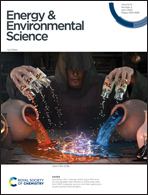Ultrathin perovskite derived Ir-based nanosheets for high-performance electrocatalytic water splitting†
Abstract
Ultrathin two-dimensional (2D) nanostructures attract increasing attention due to their unique properties and resultant applications in diverse fields, yet the controllable synthesis of ultrathin 2D nanostructures without capping agents remains a challenge. We here report a robust strategy for fabricating 2D Ir-based ultrathin nanosheets (NSs) (1.3 nm) without capping agents through the thermal treatment of ZnIr(OH)6 perovskite hydroxide. Encouragingly, the created ultrathin Ir-based NSs exhibit high stability against a high temperature (e.g., 300 °C) and excellent performance towards overall water splitting. The cell voltages for reaching 10 mA cm−2 are as low as 1.482 and 1.508 V in alkaline and acidic electrolytes, respectively, which are significantly lower than those of commercial Pt/C||IrOx (1.548 V in alkaline and 1.553 V in acidic electrolytes). This work not only provides a facile strategy for the synthesis of capping agent-free 2D Ir-based NSs, but also promotes the fundamental research studies on catalyst design for electrocatalysis and beyond.



 Please wait while we load your content...
Please wait while we load your content...